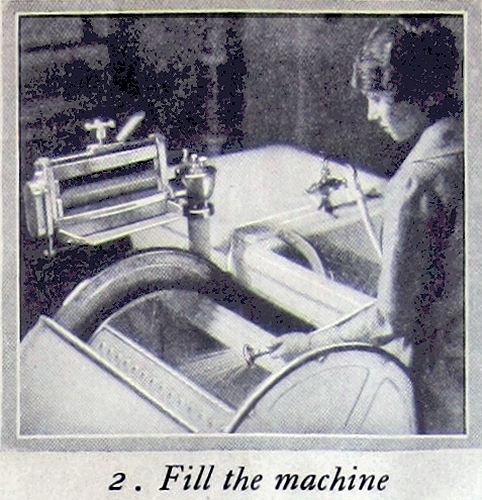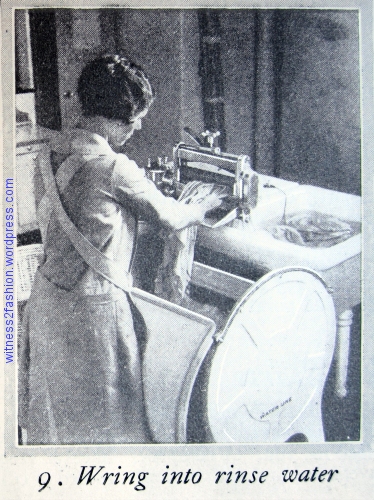
“The punishment your clothes get in an ordinary washing is harder on them than all the wear you give them the rest of the week. You can’t afford to let the old hard laundry soap wear out any more clothes in the washing.” From a Lux ad, Delineator, August 1926.
Modern Methods of Laundering, article from Delineator magazine, July 1927.

“Modern Methods of Laundering,” Delineator, page 40, July 1927.
This full-page article described the way to do laundry in 1927, with step-by-step illustrations. I will show the images and text, from number 1 to number 11, with occasional comments or explanations. (Even if you’re hauling your laundry to a laundromat every week, reading this article may make you glad it’s not 1927.)
The horizontal washer used in the “Methods” illustrations is less familiar than this upright “Mangle washing machine,” but the steps would be the same.

Ad for a Thor washing machine, Delineator, November 1928, p. 78.
First, Prepare Your Soap

Laundry soap options in 1927. They included purchasing flakes, chips, or powder; liquifying your soap ahead of time(right); and (left) grating your own laundry soap from a bar. Fels Naptha soap, which came in a big bar, was rubbed on difficult stains and rings around the collar.

Hook Up the Hose

Filling the washing machine. There was wide variety in washing machine styles; this one is cylindrical. 1927. She is filling it by hand with a hose attached to her sink’s faucet, and presumably has a hot water heater. Earlier washers were filled bucket by bucket, with water heated on the stove.

Weigh the Clothes

Weighing a load of laundry. The Savage brand wringerless washer could handle ten lbs. With wringer type washers, clothes were constantly being removed from the washer, and others were being added.

In 1927, too big a load could burn out your motor. White clothes were pre-soaked or pre-washed with borax and soap. Borax is a naturally occurring mineral that converts some water molecules to hydrogen peroxide — which is increasingly being used instead of chlorine bleaches.

Adding soap to a 1927 washer. You were supposed to dissolve the soap before putting it in the machine, to be sure it would dissolve completely. Even in the 1950s, laundry soap didn’t always dissolve in cold water.

Find the Electric Switch (and the Emergency Stop)

This power switch is inconveniently located near the floor. Notice the faucet for draining water out of the washing machine.

Another article mentioned the importance of having an easy-to-reach emergency shut-off for the electric wringer. Just the other day I met a woman who remembered getting her braid caught in the wringer when she was a girl. Luckily, she could reach the switch before her head was pulled up against the wringer. Serious injury was possible if you couldn’t reach the wringer switch. Since you used your fingers to guide the laundry into the wringer, you had to pay attention.
Watch It Make Suds

You could not trust the soap to dissolve evenly, and women didn’t trust a soap unless it made lots of suds.

Here, you can see the wringer, in profile, next to the woman’s head. Presumably, this control lever is also the safety switch.
Load Washer, Set Alarm Clock

Adding the clothes while the washer is running.

(The wooden rod was also used for moving laundry around in the washer.)
Uh-oh: the overnight soak or preliminary washing, and the first run through the wringer, apparently had to be done ahead of time.

1927: Before the kitchen timer or automatic wash cycle…. Once the alarm clock was set, the laundress hurried to do other tasks.

Make Starch on the Stove
While the machine was washing sturdy fabrics, delicate silks and hosiery awaited hand washing. And liquid starch had to be made. I don’t know what “tinted” means in this context, but fabrics were not always colorfast. And some whites had to be “blued.” This would also be a chance to lug a heavy basket of wet laundry out to the yard and hang it on the washline with clothes pegs or clothes pins. In Spring and Fall, the wash had to be hung out earlier in the day.

Ad for Quick Elastic Hot Starch, WHC, Nov. 1936. It was “quick” because you didn’t need to cook it — just dissolve it in cold water and then add hot water. Stir.
“It parallels the advance in … automatically heated irons. Practically self-cooking….. Thin it down to give any degree of gloss or delicate “sizing.” Clothes which needed to be starched were dipped in liquid starch while damp, and wrung out before ironing.

Tending the washing machine (L), hand-washing delicates (C), boiling the whites on a low laundry stove (R.) Fels Naptha soap ad, Delineator, March 1927. Boiling hankies and diapers controlled germs. Boiling long underwear killed lice.
In 2017, I when set my high efficiency, low-water use washing machine, it weighs the load, does the pre-soaking, one or two rinses as desired, and “wrings” out the wash water and the rinse water in a spin cycle — while I leave the room and do something else. In 1927, even with an electric washer — which not everyone had — doing the laundry meant tending the wash constatntly.
Put Through the Wringer

Clothes were fished out of the sudsy water and “put through the wringer one at a time.” In 1950, my grandmother had a special wooden pole, about three feet long, for lifting clothes out of the hot water, or insuring that the load stayed evenly distributed.

Boiling and Blueing
The use of scalding hot water explains the importance of Sanforized, pre-shrunk fabrics in shirts and other clothing.

Ad for Sanforized-Shrunk dresses, Delineator, Sept. 1933. The “Sanforized” process was introduced around 1930.
About blueing: As explained in RememberedSummers, “Laundry had to be hung out to dry in your yard, in fresh air, which meant that it was exposed to public view. Most back yards contained two tall posts (picture small, square telephone poles) with four or more clotheslines strung between them from the crossbars…. Of course, in the old days, all of your neighbors hung out laundry on the same day you did (Monday), so there was some competition as to who had the whitest sheets. In the 1940s , my grandmother always put blueing in her final rinse [to get the yellow out.]” (And yes, some “blue-haired old ladies” used it on their hair! Don’t!)



Ad for Staley’s Gloss Starch Cubes, WHC, Nov. 1936.
Without starch, inexpensive fabrics became limp. If you wanted to keep cottons looking new, you needed to starch them before you ironed them.
But, before you were ready to iron the rest of the laundry, you had to dry it. This is not what I think of when I read the word “dryer:”

A heated cupboard for indoor drying. 1927.

Hung Out to Dry
I have never visited a house with a dryer like this, but then, I live in sunny California. Clothes were normally dried out of doors …

Drying clothing in the air, Borax ad, 1924. A solar and wind powered dryer.
Solar and wind powered drying, the laundry line worked well for at least half of the year. But air drying doesn’t get the wrinkles out of modern permanent press clothing. Some modern planned communities even forbid laundry lines as unsightly.
My Texas-born husband tells me that in really cold weather, laundry will freeze dry — or at least, dry enough to be ironed. Rainy weather meant hanging your laundry to dry in the house — a messy and inconvenient necessity.
I have never known life without a washing machine, or at least a laundromat where I could wash and dry three loads at a time and be home within two hours. In 1927, that could take two days. No wonder many women “sent out” their laundry.
However, we ought to remember that, in the nineteen twenties, many American women were enjoying labor-saving inventions that have still not been introduced in many parts of the world. It’s time to remember how lucky I am.
